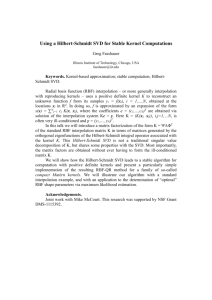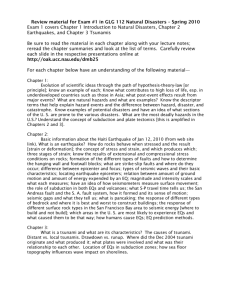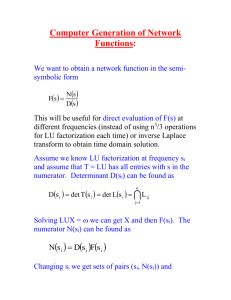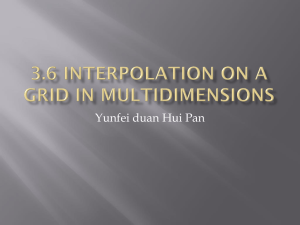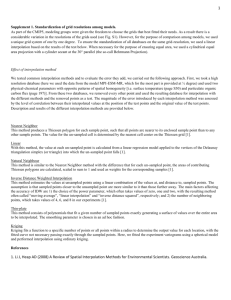Computational Molecular Biology
advertisement
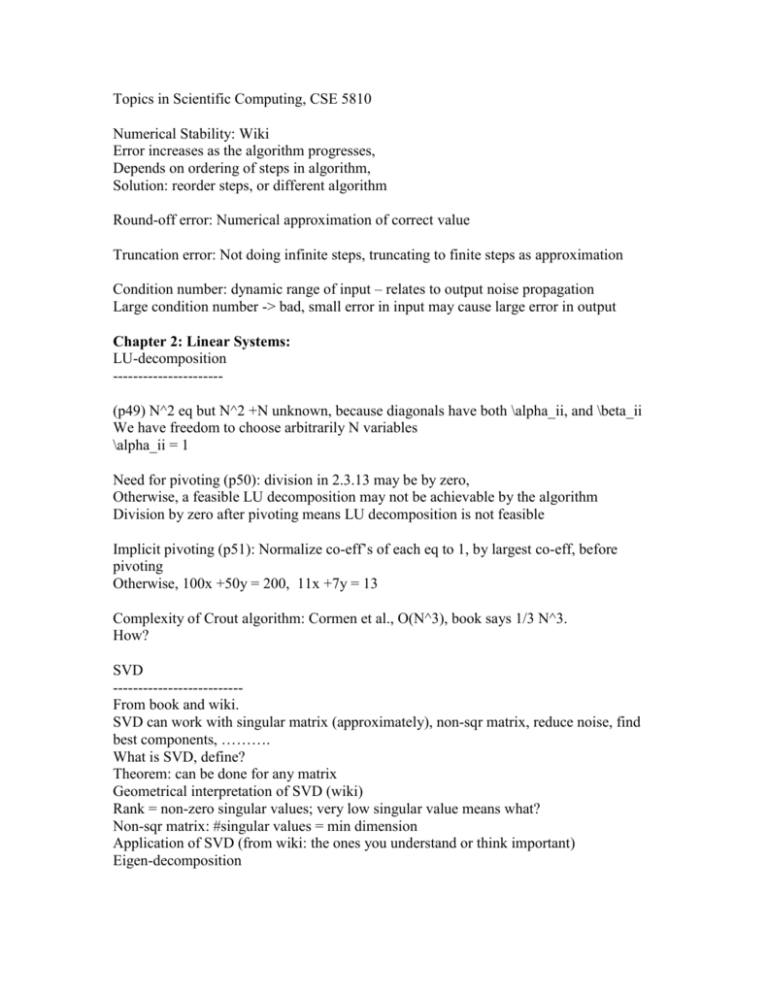
Topics in Scientific Computing, CSE 5810 Numerical Stability: Wiki Error increases as the algorithm progresses, Depends on ordering of steps in algorithm, Solution: reorder steps, or different algorithm Round-off error: Numerical approximation of correct value Truncation error: Not doing infinite steps, truncating to finite steps as approximation Condition number: dynamic range of input – relates to output noise propagation Large condition number -> bad, small error in input may cause large error in output Chapter 2: Linear Systems: LU-decomposition ---------------------(p49) N^2 eq but N^2 +N unknown, because diagonals have both \alpha_ii, and \beta_ii We have freedom to choose arbitrarily N variables \alpha_ii = 1 Need for pivoting (p50): division in 2.3.13 may be by zero, Otherwise, a feasible LU decomposition may not be achievable by the algorithm Division by zero after pivoting means LU decomposition is not feasible Implicit pivoting (p51): Normalize co-eff’s of each eq to 1, by largest co-eff, before pivoting Otherwise, 100x +50y = 200, 11x +7y = 13 Complexity of Crout algorithm: Cormen et al., O(N^3), book says 1/3 N^3. How? SVD -------------------------From book and wiki. SVD can work with singular matrix (approximately), non-sqr matrix, reduce noise, find best components, ………. What is SVD, define? Theorem: can be done for any matrix Geometrical interpretation of SVD (wiki) Rank = non-zero singular values; very low singular value means what? Non-sqr matrix: #singular values = min dimension Application of SVD (from wiki: the ones you understand or think important) Eigen-decomposition Computation of SVD (remember reordering of rows/columns in decreasing order of sing. Values) ALGORITHM/CODE IS NOT AVAILABLE IN BOOK, BUT YOU NEED TO FIND Demo must include: Find range, nullity, and rank of a matrix, least square solving by SVD, image transformation by SVD or other real applications 2.6.1 range, null-space, etc,: A: x -> b, is function 2.6.2 inversing matrix: Condition number of A is largest to smallest wj ratio A: x -> b, is function For b=0, solution is in x A full-rank, square, x-b is unique mapping A: non-square or lower-rank, then over determined or under-determined Over-determined: SVD finds lowest length solution out of all possible ones Under-determined: SVD finds x with min b-Ax error If wj is small (A is almost singular), put that W-inverse element 0 instead of infinity: Pseudoinverse / Moore-Penrose inverse Proofs of over/under-det cases are in book By 0-ing 1/wj for small wj, SVD ignores some “useless/corrupting” solution vectors 2.7.6 Conjugate Gradient: Needed in later chapter for minimization – ch 9 Another method for solving linear set of equations 2.7.29 Iterative minimization of residual eq 2.7.30, 2.7.31 Solution space over domain x, draw Show how direction and step are found in each iteration eqs. 2.7.32, 2.7.37 Bi-conjugate, understand, condition eqs. 2.7.33-35, geometrical interpretation Stopping condition eqs. 2.7.36 Theoretical gurantee of stopping in N steps for dimension=N, but…. (1) only for exact arithmetic, not in practice, (2) in practice unstable alg for general A CG for symmetric matrix – still uses bi-conjugate technique but with r0-bar =r0, and so Symmetric but non-positive definite min. residual alg, with eq 2.7.38 Unsymmetric matrix, GMRES alg, minimize eq. 2.7.39 Ignore “pre-conditioner” A~ eq 2.7.41 - - , for now Do not use A^T . A, has high condition number (ideal cond. No.=1, for I-matrix) Preconditioned, PBCG alg, eq. 2.7.41, efficient version with eqs. 2.7.42-43 4 stopping choices with itol=1/2/3/4 in code Linbcg Question: which version of alg do we use? Low priority over class-time, for now: Code&demo Linebcg function by solving a small example 3.0 Interpolation (GO OVER SLOWLY) Data points -> to a functional form Even locally, actually better, because global fit may be wrong Purpose: evaluate function at given x-coordinate = interpolation / extrapolation Function-types: polynomial, rational, and Trigonometric Local interpolation: over M points around given x, where M<<N all data points Local interpolation is real-time Function representation: with co-efficients of basis, poly->a0, a1, a2, etc., sin/cos -> Fourier co-effiients Local may be further local over a support -> e.g., 4 points for cubic polynomial, 3 points for quadratic, 2 pts for linear interpolation Higher order polynomial fit oscillates too much (overfitting) -> spurious interpolation Piece-wise smooth over M points -> spline Cubic -> second order derivative same, Sqr-> first order derivative smooth,,,, Higher order polynomial fit are not good as above (TRY IT!) Coding: linear for understanding the base functions, cubic for real, And barycentric is more stable 3.1 on code: searching where to interpolate given x First, pre-search for bracketing a bound, then logarithmic binary search to locate exactly, Then choose M points around x 3.2 Polynomial interpolation Eq 3.2.1 Langrange’s interpolation formula Neville’s algo to combine lower order polynomial eq 3.2.2, recursive formula eq 3.2.3 Further improvement for more tracking eqs. 3.2.4 & 3.2.5 3.3 Cubic Spline Smooth first derivative, continuous second der. : read a bit on smoothness of function on wiki Decision: make D2 constant over (internal) points Gets to eq 3.3.3 Needs two more conditions for solving – boundary points’ D1 is chosen: (1) D2’s =0, or (2) D1 with two previous internal points SHOW HOW EQ 3.3.3 IS DERIVED Eqs 3.3.5 & 3.3.6 are how the interpolation is done – algorithm Practical advantage: Matrix is sparse – tridiagonal, previous chapter’s O(N) algo used (we did not cover that) 3.4 Rational interpolation: polynomial also in denominator Note: often M and N are mixed Can handle poles in interpolating function better, but… <Pede approx., diagonal rational function???>> Neville-like algorithm eqs 3.4.3 – 3.4.8: rational interp. code can be adapted 3.4.1 Barycentric interpolation Discrete interpolation formula may create poles when none exists in the original rational interp. : hence Barycentric interpolation Form: eq. 3.4.9 How to find weights w_k: eq. 3.4.10-11 Vandermonde matrix inversion eq. 3.5.1-2 One-by-one co-eff extraction sec 3.5.1 3.5.0-1: Co-efficients of interpolating function --just lecture, no coding— Vandermonde matrix inversion eq. 3.5.1-2 One-by-one co-eff extraction sec 3.5.1 3.6 Multi-dimensional interpolation e.g., image interpolation Interpolation on a grid, with some points’ values available: regular interval, or irregular intervals Bi-linear interp. formula eqs. 3.6.4-5 3.6.1 Higher order interp., e.g., cubic: 2 bilinears from 2D (DRAW) 3.6.2 Smooth higher order with spline: 2 bi-cubic splines for 2D 3.6.3 Splines all around, not just in two 1Ds: eq. 3.6.6 with co-eff c’s tabulated in the struct below Hui-Yunfei: try to understand the difference between these 3 methods 3.6.1-2-3 from other sources! The third one is of low-priority in implementing but try. 3.7 RBF, for irregular grid, but data is on scattered pts 1- create a grid where data falls on grid pts, - finite element method (GCM?) 2- move data pts to nearest grid pt! Radial function eq. 3.7.1 Solve for co-eff w_i using data points eq. 3.7.2 Then, use those co-eff to interpolate Normalized RBF, eqs. 3.7.3-4, no improvement in most cases, just statistical satisfaction! 3.7.2 Specific RBF’s Eqs. 3.7.5-8 We will not cover Krigging/ Gauss-Markov / Gaussian process regression Ch 3.7.4 Natural method for interpolation, by averaging over points around Very good in practice! Provides error measures – variance 3.8 Laplace interpolation <What is the difference with splines???> Missing data interpolation on regular grid Second partial derivative =0 all around, but data points are anchored eq. 3.8.1-2 Domain specific – minimizes total gradients over the given domain eq.3.8.3 Center averaged over neighbors around, for missing data eqs. 3.8.4-5 Middle of boundary lines: eqs. 3.8.6 Then, solve for all points, using anchored data points [DO SOME HAND CALCULATION OVER A SMALL GRID AS EXAMPLE] [READ A BIT ON THEORY – HOW EQS. 3.8.1 AND 3.8.3 ARE SATISFIED?] Ch 9 Roots of equation Ch9.0 Multi-dim function’s root may not exist Roots may degenerate: at same point multiple roots, e.g. (x-2)^2 =0 In 1D, always bracket: look for change of sign on x_min and x_max, Then find root between those pair of points Degeneracy – difficult to find sign change, bracket is useful for odd multiplicity In >1D, no such luck, but may decide on a 1D direction first Most algorithms find roots iteratively – increasing accuracy, up to precision Smooth functions converge nicely, in 1D Good to have idea on the function – plot 9.0.1 Bullets: intro on where to use different algo, Newton-R: bracketing not trivial 9.1 Bracketing Continuous fn changes sign around a root Discontinuous fn: step discontinuity, -> sign change Singularity, e.g. eq 9.1.1 -> bracketing will detect but abs(fn) is inf, So, evaluate after finding root! 9.1.1 Bisection Binary search really Complexity eq 9.1.3, log on starting interval Always finds one root or singularity Analytical root may be beyond machine precision, hence, converge only up to predefined precision 9.2.0 Secant method Fig 9.2.1 False-position Fig 9.2.2 Slow convergence of False-pos. Fig 9.2.3 9.2.1 Ridder’s method Quadratic fit: eqs. 9.2.2-3 ?Why e^Q, =P should do! Find x4 given x1, x2, x3, then iterate taking 3 of these 4 Quadratic fit may get outside bound Convergence root-2 superlinear >1 9.3 Brent Inverse quadratic eq. 9.3.1 Correction over middle term b of the three points a,b,c, eq. 9.3.2 If correction one outside bound (or slow convergence) Brent uses bi-section, thus, speed + correctness 9.4 Newton-Raphson Derivative computable/available Correction term eq. 9.4.2, iterate as eq. 9.4.4 Convergence eq. 9.4.5 or 9.4.6, fast – precision doubles every iteration Avoid machine computing derivative: (1) speed reduces, (2) error compounds NO: 9.4.1 fractal, 9.4.2 Halley’s 9.5 Roots of polynomial Degeneracy – multiple roots – bracketing is problem 9.5.1 Deflation Find a root – divide polynomial – find next root Reduces order gradually, but Error of one root propagates to next – compounds Forward deflation / Backward: highest power of x to lowest, / Reverse ?End-to-end: divide by highest power, next step find 1/root, etc. Root polishing: find approximate root, then converge to more accuracy 9.6 Newton-Raphson on Non-linear system of eqs. Problem: Fig 9.6.1 Local minimum problem: “no root here! - in same Fig. 9.6.1 Method: eqs. 9.6.3, 5, 6 Iteration with correction eq. 9.6.7 9.6.1 Jacobian has well-defined surface to travel on, and find minima, unlike vector-F system of functions 9.7 Global convergence (??) for non-linear system of eqs. Minimize eq. 9.7.4 Step vector eq. 9.7.3 needs Jacobian (partial derivative over multiple dimensions) ?Descent eq. 9.7.5 ?Backtrack – when? 9.7.1 Line search Steps eq. 9.7.6 Convergence guarantee eq. 9.7.7 Finding step size lambda on backtracking eqs. 9.7.8-11 When gets closer to root, better lambda eq. 9.7.14 9.7.2 Globally convergent (??) Newton INCOMPLETE NOTE ON CH 9 ….. Ch 10 Optimization Ch 10.1 Bracketing Three points with middle one having lowest function-value Note: Make distinction between x-coordinate and y-coordinate/function – gets confusing sometime Iterate replacing 3 points Ch 10.2 Golden search Best replacement is to have mid-pt at golden ratio 0.38/0.61 between the 2 extremes, Proof: Eqs. 10.2.3-7 This gives linear convergence rate: eqs. 10.2.1-2 Closest to real minimum attainable here is Sqrt(Computer’s precision): eq. 10.2.2 Ch 10.3: Quadratic convergence with parabolic interpolation Faster than linear but may take minimum-of-the-iteration outside bracket, So, generally not advisable Compromise is Brent: quadratic runs only when “close” to the minimum, But if mid-pt is outside bracket, then reject it and go back to Golden-search again “Closeness” measured using eq. 10.2.2 w.r.t comp-precision Parabolic: needs 3 pts’ (x, y) co-ordinates to draw parabola y=f(x), Then chooses x-coordinate of the bottom of the parabola analytically, this becomes one of the 3 points for next iteration, but not necessarily mid-pt: Fig 10.3.1 Ch 10.4 Analytical derivative as a function is available But, book refuses to use it for higher order interpolation– may take min point outside bracket So, derivative’s sign on mid-pt is used only to see which direction to go, Note, derivative=0 indicates real lowest-pt found DBrent code is this compromise Ch 10.6 Multi-dimensions Choose one line for minimization first – (1) direction vector, and (2) amount scalar, in each iteration In 1D only second one above was needed Ch 10.7 Powell’s method with conjugate directions Once direction vector is decided, line-min from Ch 10.6 is done Conjugate directions: make sure directions are perpendicular to each other from iteration to iteration, Why? Otherwise, you may go back and forth on same direction – idea is to preserve previous moves’ improvements toward minimum Eqs 10.7.1-2 for Taylor expansion Eq 10.7.3 condition for minimum – gradient zero Eq 10.7.5 – how to get conjugate gradient Ch 10.7.2: Powel’s method Only N previous gradients necessary for convergence, where N=dimensions Bullets show how to choose next gradient – especially, bullet 4 N iterations need 1+2+3+…N =N(N+1) linmin calls Strict conjugate finding may go to a “wrong answer” (some directions unexplored?) – Fig 10.7.1 Ch 10.7.3 So, use eq 10.7.7 for gradient replacement Exact procedure: items 1-2 on p513 second para Ch 10.8 Partial derivatives may be analytically calculated Availability of gradients reduces #linmin from N^2 to N, but Each gradient compute also takes time, so, improvement is not of order N, but still some improvement A gradient-component may be same for some direction for nearby points making resusage (but, how would one know?) Steepest descent algo (bottom pg 515) – always follow local gradient: is not good: Too many small steps (cf Fig 10.8.1) Using past (and conjugate) gradients makes CG to take bolder/longer steps Contd. Ch 10.8 CG (We need a theory paper/text to understand!!) 2 vectors are tracked in iterations g, h: Eq10.8.2 (What are physical meanings of them?) They are conjugate, to each other, and over past iterations: Eq 10.8.3 Parameters, lambda and gamma ensures orthogonality, when computed using Eqs. 10.8.4-5 Hessian is not needed with these lambda and gamma in eqs. 10.8.4-5 (Pf in eq10.8.6) Polak-Ribere’s correction over above Fletcher-Reeve Eq10.8.7, for not-exact quadratic form Ch 13 -13.1.2 Spectral Analysis Needs some code (at least) from Ch 12 FFT Note the basis function-form (Ch13.0 pg640) FFT is just an efficient algorithm for doing DFT – O(n logn) as opposed to O(n^2) Fig 13.1.1 – convolution =moving window averaging, weighted Second function is operator/response function of detector, first one is operand/signal Convolution Thm: end of pg642, point-to-point mult in frequency domain is same as convolution in time domain Signal end needs extending with zero – operator to act fully on each end Ch 13.1.3 Large data set Block-wise FFT-convolution Be careful on wrap-around end effect Ch 13.2 Correlation Meaning of correlation, lag = movement Eq 13.2.2: definition In frequency domain, Eq 13.2.3 For 2 real time serieses imaginary part will be zeros: TEST IT Ch 13.3 Weiner filtering Two types of noises: 1. point-response convolved, and 2. Random additive noise Problem: extract expected signal Two assumptions: 1. Point-response known and invertible, 2. Additive noise is uncorrelated to signal / random Least square formula: Eqs. 13.3.4-5 Minimized filter in frequency domain, Eq. 13.3.6 Take power spectrum, Fig 13.3.1, then figure out what it should be, then filter out “noise”, then extend toward negative frequency symmetrically, lastly invert back to time domain Do not apply iteratively – filtered signal will go to zero, this is not an iterative algorithm Ch13.10 Wavelet Orthogonal basis functions (as sinusoidal, in FT) Invertible transform (as time-frequency in FT) Efficient DWT (as FFT) ??Spares operator Ch 13.10.1 Debauchies Wavelet DAUB4 Eq 13.10.1, note wrap around last line It would be FT if even rows are same as preceding odd rows Odd rows – moving window average, even rows low-cut filter-type: Convoluted Orthogonality demands, eq 13.10.4, with normalization eq 13.10.3, solving to values in eq 13.10.5 DAUB6 values eq 13.10.6 Inverse of DAUB4 transform by eq 13.10.2, source of ortho-normalization equations 13.10.3-5 Ch 13.10.2 DWT FFT type transform-butterfly iterations, eq 13.10.7 Inverse, similar, from right to left, but with inverse transform Wrap around on last rows to be handled specially in code Ch 13.10.3 Debauchies visualization Figs. 13.10.1 Differentials are not continuous!


